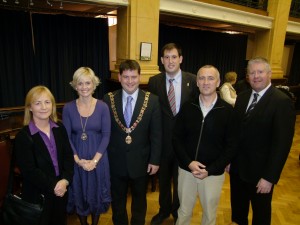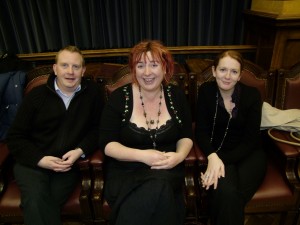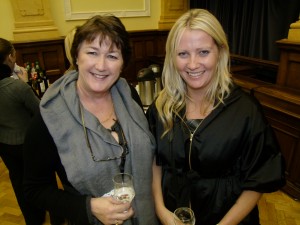
Last Thursday (5 November), there was a celebration in the Council Chamber of City Hall to mark the great work of owners and staff involved in Heritage Open Day. The event was organised by the City Council’s Heritage Officer Niamh Twomey. The Lord Mayor Cllr Dara Murphy said a few words as did I (see below).
Many thanks to all the owners of the buildings for your hard work and showing everyone around. Here’s to next year!
Kieran’s Speech:
Open for Debate
Lord Mayor, Lady Mayoress, Cllr Mick Finn, Ladies and Gentlemen,
Many thanks for taking up the invite this evening. We are all here to celebrate the legacy of Heritage Open Day.
The Day itself is about discovering thirty of Cork’s hidden gems, whose legacies cross centuries and also cross a wide variety of themes from religion to entertainment to commercial. These buildings are normally open for select few people who work in them.
The thirty or so buildings present many views to the onlooker. They serve in part as an introduction to the development of Cork. They are a type of landscape textbook informing us of the city’s rich architecture. They provide a worldview of the time of their construction – the beliefs and politics of the time.
Perhaps most importantly and often forgotten about in the written record of Cork’s past they give one access to the imagination and efforts of the people who drew up the design, the people who had sleepless nights thinking about their work and the people, the actual workers who strived hard and long to bring and weave the jigsaw pieces of an architect’s imagination together.
In fact, it is all too easy to reduce the buildings to facts, dates and figures. Visit anyone of them – take for example the Everyman Palace or Cork Opera House. Here for over one hundred years, the actor’s craft has been carved. People have come to be entertained. When the darkness falls before a show – that time between reality leaving and imagination taking over – another place is forged for the viewer to be transported to.
There are several churches open to the public from the iconic eighteenth century St. Anne’s Church Shandon to late nineteenth century Trinity Presbyterian Church.
Again these buildings are markers in the landscape that are centres of debate about the nature of people’s religious belief – their high towers pointing to the heavens but also drawing the viewer in saying look at me-
but then again what about the experience of climbing Shandon through the bell tower or taking the elevator up the Elysian Tower and looking down on the modern city with all the past, present and future dreams and hopes of the region revealed through the settlement’s buildings.
The city’s hills and troughs have created different perches for some of the city’s elaborate structures to stand on. Collins Barracks is mounted on one such perch protecting the city, its soldiers providing law and social order. Below in Blackpool, Heineken’s brewing tradition reveals a world of enterprise and innovation, its workers remembered through its multiple account books over the past 150 years.
But one should also remember the workers in the now converted warehouses, (see artist studios at Wandesford Quay), residences such as Civic Trust House on Pope’s Quay, the hotels such as the Victoria and Imperial Hotel and all those that have checked guests in and made them feel welcome in this colourful city.
Recently, I was given a tour of the National Sculpture Factory. One hundred years ago, the National Sculpture Factory was once the central hub for electric trams whose trackways created arteries through a bustling city of contrasts from slums to richly embellished Victorian terraces in the city’s middle class suburbs.
The site was also the electricity distribution centre, which illuminated the city at night creating new ways of seeing for citizens. The trams supplied a rhythm through the city – their stopping, going and wining- the iron wheels pushing into the tracks moving through the city, connecting people.
The site of the National Sculpture Factory is all about the power of place. It is a place rooted in Cork, a place of tradition, of continuity, change and legacy, a place of direction and experiment by people, of ambition and determination, experiences and learning, of ingenuity and innovation and a place of nostalgia and memory.
It like many other elaborate buildings in the city provide a cultural debate in teasing out how Cork as a place came into being.
Through the adjacent docks, Cork was connected to the outside world – the international and small city ambitious in its ventures linking to a world of adventure and exploration. The timber quays kept back the world of the tide, for reclamation in the city was still taking place as Cork Corporation sought to bring the city centre to a new place of being. However Cork City has always strived to be a new place. It has always been ambitious in its endeavours.
Cork’s urban landscape or textbook seems to be throbbing with messages about the past. The landscape serves as some kind of vast repository of symbolism, iconography and cultural debate. For me Cork’s everyday landscape is a work of art, complex – multiple and layered.
In fact perhaps the buildings themselves and because of the their legacy do ask a very important question of all of us – well what are we doing in our own time to push forward – to build our legacy
In these times, we now need more ideas, more of an idea to a sustainable future. Who are the next architects?, business people?, entrepreneurs?, we now need new people to step up, lead, inspire, encourage, bring along, forge and refresh our society and our way of life.
There is so much to explore and so much history and heritage we can harness in our modern world for survival.
In terms of the heritage open day, I sincerely thank all those who worked so hard to bring the day to fruition but I also now call for even a closer partnership between yourselves and Cork City Council and develop further programmes that will enhance and development new opportunities for all who engage in the open day and all those who fight to build our cultural tourism capacity and show that yes Cork has the ability to showcase itself in every best light.
Ends.






